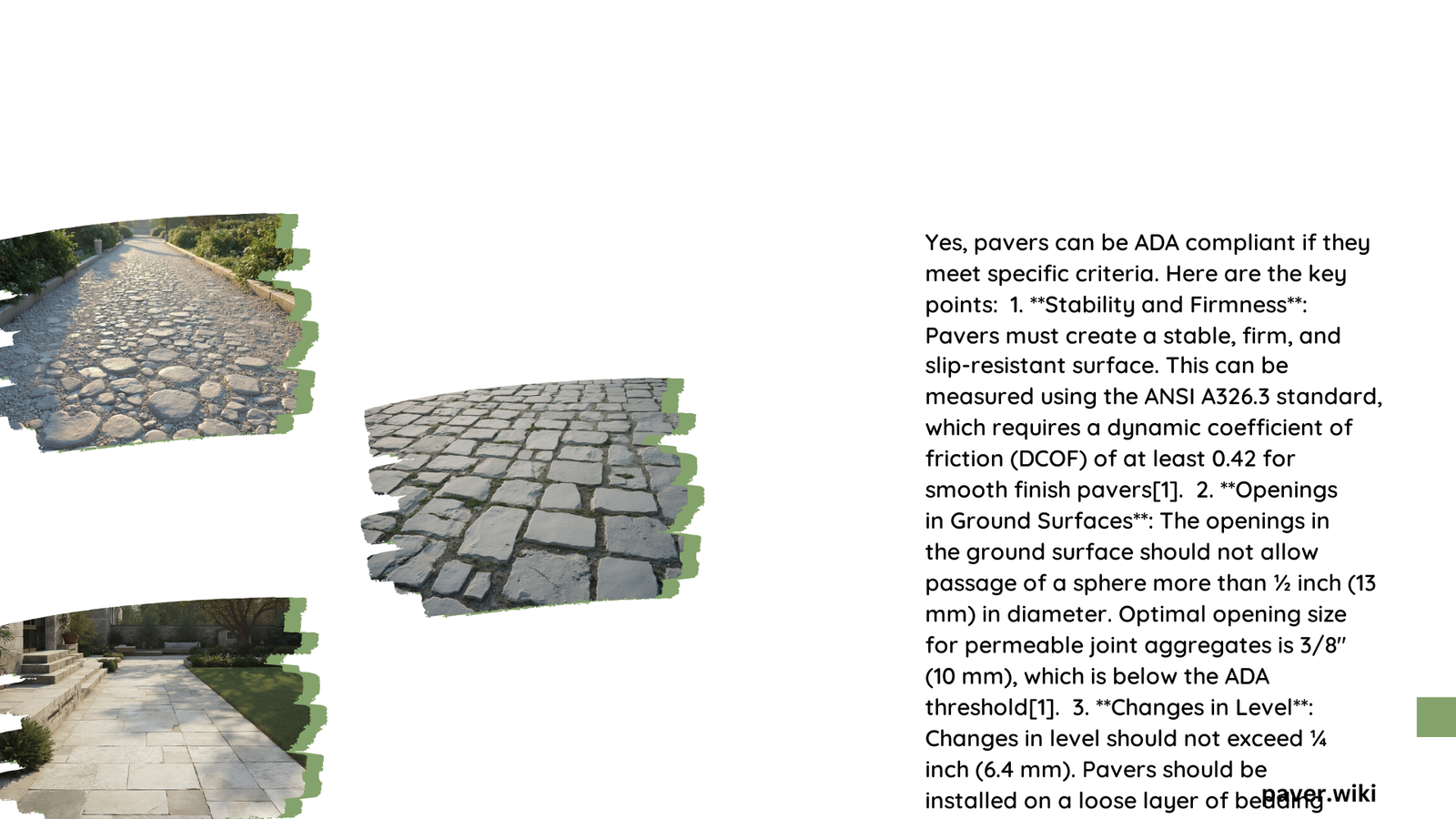Pavers can be ADA compliant when they meet specific requirements for stability, firmness, and slip resistance. The Americans with Disabilities Act (ADA) sets standards for accessible design, including guidelines for ground and floor surfaces. Compliant pavers must have a stable, firm, and slip-resistant surface, with proper installation techniques and maintenance to ensure long-term accessibility. This article explores the ADA compliance of pavers, their specifications, installation guidelines, and benefits.
What Are the ADA Compliance Specifications for Pavers?
The ADA provides clear guidelines for accessible surfaces, including those made with pavers:
Surface Characteristics
- Stability and Firmness: Paver surfaces must resist movement and deformation when force is applied.
- Slip Resistance: While no specific coefficient of friction is mandated, pavers must be slip-resistant. For example, Belgard pavers meet the acceptance criteria of ≥ 0.42 using the ANSI A326.3 test method.
- Openings: Gaps in the surface must not allow passage of a sphere larger than ½ inch (13 mm) in diameter.
- Level Changes: Changes up to ¼ inch (6.4 mm) are allowed without treatment. Changes between ¼ inch and ½ inch must be beveled with a slope no steeper than 1:2.
Pathway Dimensions
- Width: Accessible routes, including those made with pavers, must be at least 36 inches wide to accommodate wheelchairs.
Slope Requirements
- Maximum Slope: For ramps, the maximum slope is 1:12. For other accessible routes, the slope should not exceed 1:20 for long distances.
What Are the Specifications for ADA Compliant Pavers?

ADA compliant pavers have specific characteristics:
Material Types
- Concrete and brick are common materials for ADA-compliant pavers.
- Manufacturers like Wausau Tile and Belgard offer pressed concrete and brick pavers that meet ADA standards.
Thickness and Durability
- Minimum thickness is typically 2 inches.
- Pavers should be durable enough to withstand heavy use and weather conditions.
Surface Treatments
- Textured finishes or micro-chamfers enhance slip resistance.
- Some manufacturers, like Techo-Bloc, engineer their pavers to be skid-resistant even when wet.
How Should ADA Compliant Pavers Be Installed?
Proper installation is crucial for maintaining ADA compliance:
Installation Techniques
- Use interlocking patterns for stability.
- Include bedding aggregate and joint sand.
- Ensure proper edge restraint to prevent shifting.
Joint Spacing
- Spaces between pavers should not exceed ½ inch (13 mm).
- Typical recommended joint width is no larger than 3/8 inch (10 mm).
Drainage Considerations
- Use permeable pavers to prevent water pooling.
- Ensure proper bedding and joint filling for stability and evenness.
What Are the Benefits of Using ADA Compliant Pavers?
ADA compliant pavers offer several advantages:
Accessibility Improvements
- Enhanced comfort and safety for wheelchair users.
- Improved navigation for individuals with visual impairments when using detectable warning systems.
Legal Compliance
- Helps avoid potential fines and legal issues related to non-compliance with ADA standards.
Durability and Maintenance
- ADA-compliant pavers, especially concrete ones, are highly durable.
- They can withstand freeze-thaw cycles and heavy use.
- Regular maintenance ensures long-term compliance and functionality.
How Do Different Paver Materials Compare in ADA Compliance?
| Material | Stability | Slip Resistance | Durability | Maintenance |
|---|---|---|---|---|
| Concrete | High | Excellent | High | Low |
| Brick | High | Good | High | Medium |
| Natural Stone | Variable | Variable | High | Medium-High |
What Are Common Mistakes in ADA Compliant Paver Installation?
- Improper Joint Spacing: Gaps exceeding ½ inch can create hazards.
- Inadequate Surface Treatment: Failing to ensure sufficient slip resistance.
- Poor Drainage: Not addressing water pooling issues.
- Incorrect Slope: Installing pavers with slopes steeper than ADA guidelines.
- Neglecting Edge Restraints: Failing to secure edges, leading to shifting and unevenness.
By understanding and implementing these ADA compliance requirements, property owners and designers can create accessible, safe, and legally compliant paved surfaces that benefit all users.
References:
1. ADA Standards For Accessible Design – Belgard Commercial
2. Truncated Domes ADA Pavers – Wausau Tile
3. Defining ADA-Compliance for Interlocking Concrete and Permeable Pavers – Techo-Bloc
